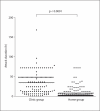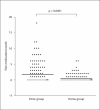Safety and efficacy of physician-supervised self-managed C1 inhibitor replacement therapy
- PMID: 22123229
- PMCID: PMC3242706
- DOI: 10.1159/000329635
Safety and efficacy of physician-supervised self-managed C1 inhibitor replacement therapy
Abstract
Background: C1 inhibitor (C1INH) has recently been approved in the USA for the treatment of acute attacks in hereditary angioedema (HAE) patients. The literature suggests that treatment with C1INH is most effective when administered early in an attack. Home infusion of C1INH allows for the earliest possible intervention since patients can initiate therapy at the first sign of symptoms.
Methods: We performed an observational, prospective study on 39 subjects with HAE utilizing two groups of patients: one receiving on-demand C1INH replacement therapy in a medical facility and the other self-managing on-demand C1INH replacement therapy in the home setting under the supervision of a treating physician. All subjects completed online questionnaires weekly for 8 weeks.
Results: There were statistically significant decreases in attack duration (p < 0.0001), pain medication use (p < 0.0001) and graded attack severity (p < 0.005) in the subjects who received C1INH in the home setting versus the clinic-based group. Attack frequency was similar between the groups. The home group experienced more frequent injection-related side effects; however, the clinic group noted more severe adverse events from C1INH.
Conclusion: Physician-supervised self-managed C1INH replacement therapy is a safe and effective treatment for patients with HAE with potential benefits in diminishing attack duration and attack severity.
Copyright © 2011 S. Karger AG, Basel.
Figures



Similar articles
-
Long-Term Efficacy of Subcutaneous C1 Inhibitor in Pediatric Patients with Hereditary Angioedema.Pediatr Allergy Immunol Pulmonol. 2020 Sep 1;33(3):136-141. doi: 10.1089/ped.2020.1143. Epub 2020 Sep 16. Pediatr Allergy Immunol Pulmonol. 2020. PMID: 32953229 Free PMC article. Clinical Trial.
-
COVID-19 and hereditary angioedema: Incidence, outcomes, and mechanistic implications.Allergy Asthma Proc. 2021 Nov 1;42(6):506-514. doi: 10.2500/aap.2021.42.210083. Allergy Asthma Proc. 2021. PMID: 34871158 Free PMC article.
-
Safety and efficacy of prophylactic nanofiltered C1-inhibitor in hereditary angioedema.Am J Med. 2012 Sep;125(9):938.e1-7. doi: 10.1016/j.amjmed.2012.02.020. Epub 2012 Jul 14. Am J Med. 2012. PMID: 22800873 Clinical Trial.
-
Update on therapeutic developments for hereditary angioedema.Allergy Asthma Proc. 2009 Sep-Oct;30(5):500-5. doi: 10.2500/aap.2009.30.3282. Allergy Asthma Proc. 2009. PMID: 19843404 Review.
-
C1-Inhibitor: Structure, Functional Diversity and Therapeutic Development.Curr Med Chem. 2022;29(3):467-488. doi: 10.2174/0929867328666210804085636. Curr Med Chem. 2022. PMID: 34348603 Review.
Cited by
-
High attack frequency in patients with angioedema due to C1-inhibitor deficiency is a major determinant in switching to home therapy: a real-life observational study.Orphanet J Rare Dis. 2016 Sep 29;11(1):133. doi: 10.1186/s13023-016-0518-8. Orphanet J Rare Dis. 2016. PMID: 27686124 Free PMC article.
-
WAO Guideline for the Management of Hereditary Angioedema.World Allergy Organ J. 2012 Dec;5(12):182-99. doi: 10.1097/WOX.0b013e318279affa. World Allergy Organ J. 2012. PMID: 23282420 Free PMC article.
-
In pursuit of excellence: an integrated care pathway for C1 inhibitor deficiency.Clin Exp Immunol. 2013 Jul;173(1):1-7. doi: 10.1111/cei.12083. Clin Exp Immunol. 2013. PMID: 23607500 Free PMC article.
-
Self-administered C1 esterase inhibitor concentrates for the management of hereditary angioedema: usability and patient acceptance.Patient Prefer Adherence. 2016 Sep 7;10:1727-37. doi: 10.2147/PPA.S86379. eCollection 2016. Patient Prefer Adherence. 2016. PMID: 27660422 Free PMC article. Review.
-
Therapeutic management of hereditary angioedema: past, present, and future.Balkan Med J. 2021 Mar;38(2):89-103. doi: 10.5152/balkanmedj.2021.21094. Balkan Med J. 2021. PMID: 33724190 Free PMC article.
References
-
- Agostoni A, Cicardi M. Hereditary and acquired C1INH deficiency: biological and clinical characteristics in 235 patients. Medicine (Baltimore) 1992;71:206–215. - PubMed
-
- Bork K, Meng G, Staubach P, Hardt J. Hereditary angioedema: new findings concerning symptoms, affected organs, and course. Am J Med. 2006;119:267–274. - PubMed
-
- Nzeako UC, Frigas E, Tremaine WJ. Hereditary angioedema: a broad review for clinicians. Arch Intern Med. 2001;161:2417–2429. - PubMed
-
- Frank MM, Gelfand JA, Atkinson JP. Hereditary angioedema: the clinical syndrome and its management. Ann Intern Med. 1976;84:580–593. - PubMed
-
- Davis AE., 3rd C1INH and hereditary angioneurotic edema. Annu Rev Immunol. 1988;6:595–628. - PubMed
Publication types
MeSH terms
Substances
Grants and funding
LinkOut - more resources
Full Text Sources

